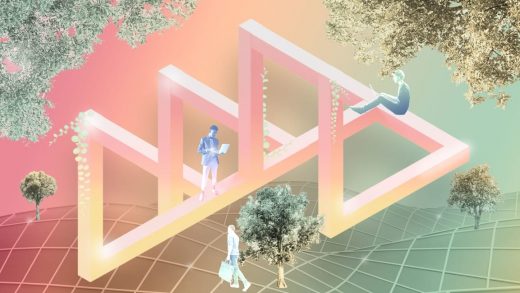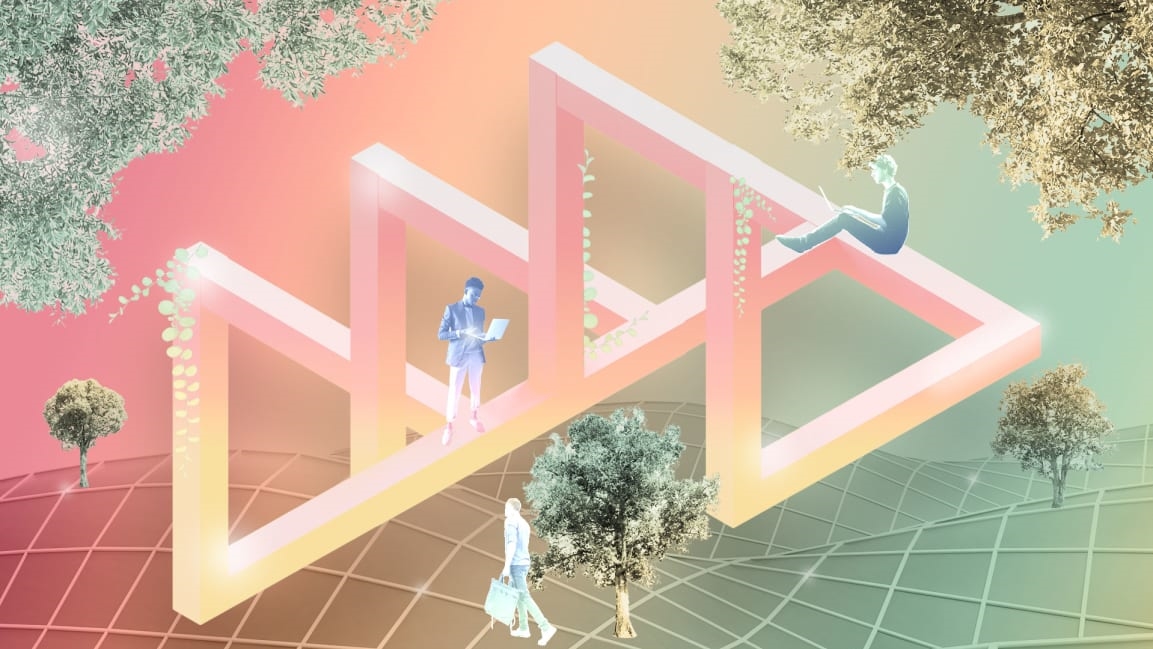5 top designers imagine the workplace of 2040
The modern workplace is ripe for change. It’s safe to say that the myth of the open office as a beacon of work collaboration and efficiency has been thoroughly debunked. And somewhere between the fall of WeWork, the torchbearer for coworking spaces; the growing trend of remote work; and the gray cubicles we all remember from Office Space, we will find the office design of tomorrow. The nature of work is in flux. Therefore, the nature of office design is in flux, too.
As part of Fast Company‘s Work in 2040 package, which examines work culture, the nature of people management, artificial intelligence and data, and even how global warming will affect your 9-5 in 2040, we asked five top designers and architects to skip the immediate growing pains of shifting work culture in 2020 and imagine what the office design 20 years in the future might look like. Then we gave them free rein.
The results range from an office with streets in the sky; to biophilic architectural structures made from fungus and bacteria; to an aquatic workplace made of pools (anyone want to take a dip in the shark tank?). One thing is guaranteed—all the concepts will make you think, whoa.
An office with streets in the sky
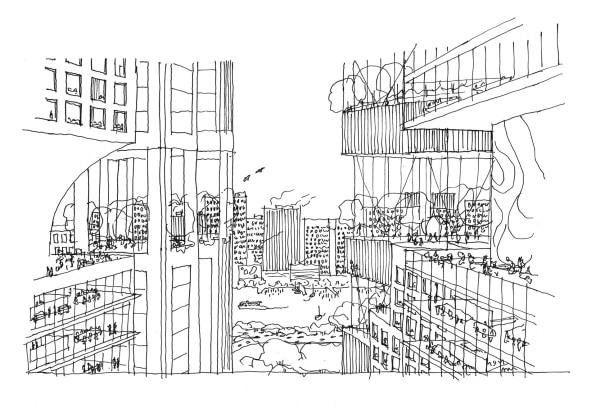
Safdie Architects
The physical relationship between working, living, and playing will become more fluid—which will be more consistent with our culture. The spaces may take the form of multistory glazed (or open-air) atria and parks at the mid heights of buildings, say 20, 30, or 40 stories in the air, with indoor and outdoor spaces linked to adjacent buildings via bridges, creating networks of streets in the sky. They would capture natural daylight and breezes, feature spectacular views of the surroundings, feature gardens and other amenities, and most importantly, break down the traditional separations between the working space and the surrounding city.—Jaron Lubin, design principal
Work, inspired by Mother Earth
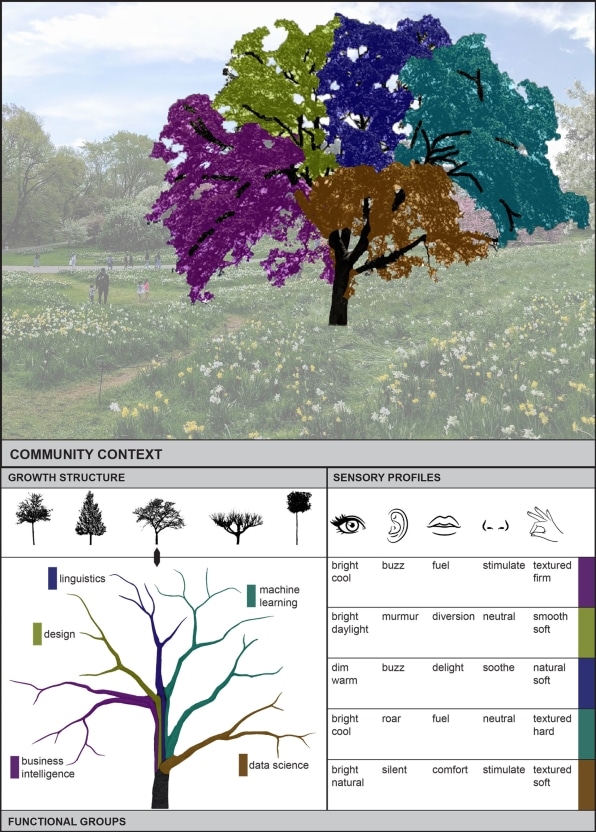
Herman Miller
The office of the future will be unrecognizable by today’s standards, but not for the reasons that you might think. Yes, tech, tech, tech, but in 2040, workplaces will behave and feel a whole lot more like nature.
By 2040, artificial intelligence will help us master the art and science of translating complex relationships–the cultural and operational DNA of organizations–into dynamic, data-driven connections with the built environment. As new individuals join and as existing members evolve, our physical environments will adapt, just like a coral reef or rainforest that’s impacted by the addition or removal of species.
Sounds far out, but it’s not a new idea. In 1968, visionary inventor Robert Propst proclaimed, “the total behavior of an organization, its goals, values, people, defines the true growth structure required. Appropriately this is not just one thing. It is properly as variable as the difference between the structure of a rose and an oak tree. Both are alive, growing, obeying the laws of total relative adjustment but with different end goals.”
Beyond serving as a blueprint for org structures, nature also provides a guide for sensory engagement. Unlike today’s sensorially static offices, the workplace of 2040 will reflect and amplify the diversity and richness of life. Within the workplace, each functional group is distinguished by a unique sensory profile that benefits the nature of their work. As cognitive science reveals more about the mind and intelligence–both human and artificial–we’ll align the sensory stimuli of environments with the cognitive function of people. —Joseph White, director of workplace futures and insight
A whole new meaning to coworking: survival
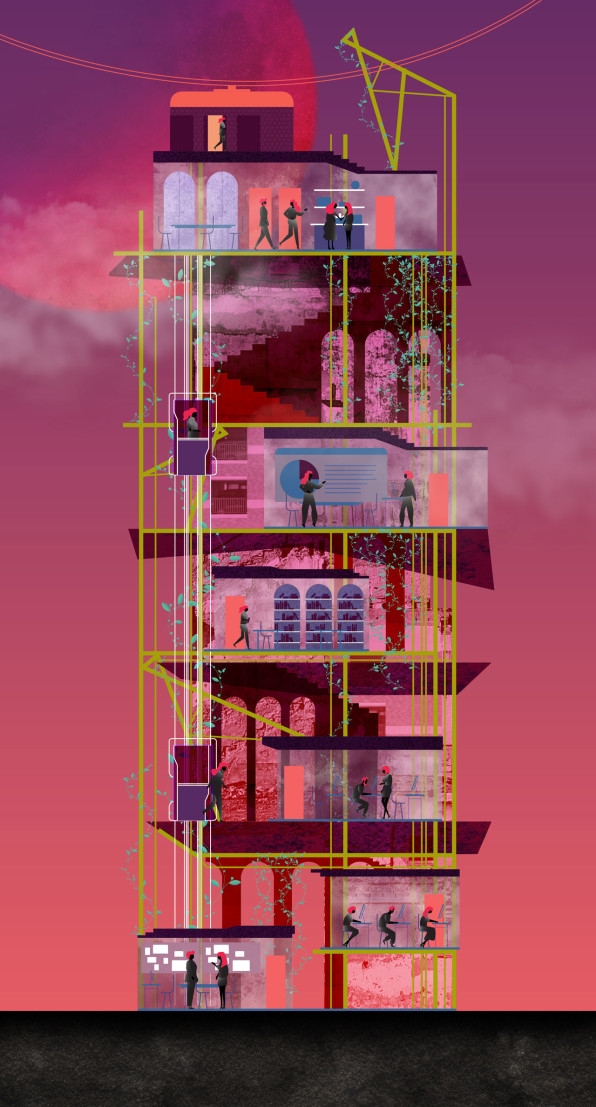
[Illustration: Minnee Pham]
Studio O+A
Our vision for a workplace in 2040 cannot ignore climate change. We imagine that by 2040, the world population will have leveled off. Even though only net zero buildings will have been built since the 2020s—and despite the huge influx of people moving to urban areas—there will have been a moratorium on new construction for almost 10 years.
So desk and office sharing will be mandated of all businesses with empty or underused space. Unused space in homes will be converted to remote offices as well. Most old buildings will be retrofitted in a variety of ways for new purposes and to create more space. A new architecture of add-on or pop-up structures will blossom. The aesthetic is like barnacles. Pop-up structures often make buildings unrecognizable from their former selves. These add-on structures will be made of bambu (a fast-growing, wood-like variation of bamboo) and other living materials mostly originating from fungus and bacteria. These materials will create breathable walls and surfaces. All design will be biophilic, and plants will be everywhere, as they will help with the poor air quality and pull carbon out of the atmosphere, a task that every person young and old will pitch in on.
One positive outcome of the climate catastrophe is how the idea of work will change. With everyone coming together for the sake of sheer survival, fundamental shifts in economics and business practice will take place. International business will mostly be conducted through incredible new technologies that allow us to interact virtually through avatars. As a result, many more people will work from home, and so a host of spaces will be converted to community connection centers where people come together to exchange ideas and get their social fix, almost like the agora of ancient Greek civilization. —Verda Alexander, founder. Illustration by Minnee Pham
An office space for daily living
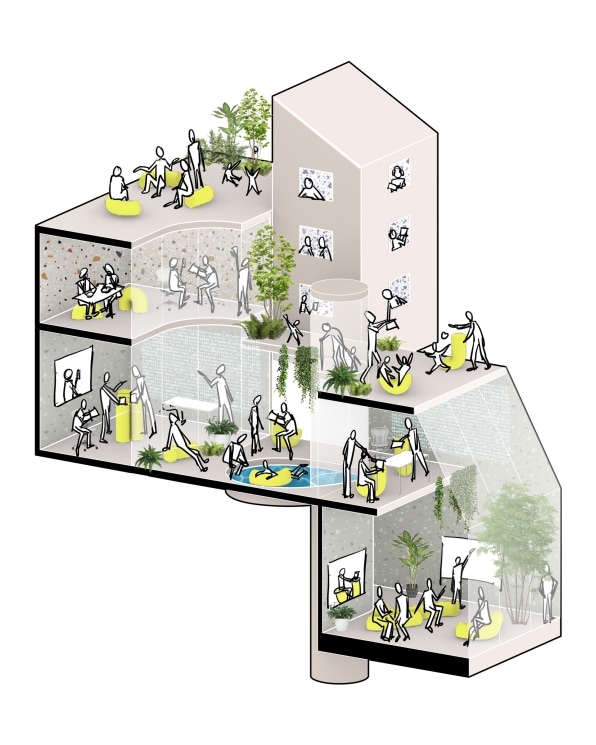
[Illustration: Alda Ly, founder and principal, Alda Ly Architecture
Alda Ly Architecture
The workplace of 2040 feels surprisingly familiar. Technology will reduce the need for physical proximity at work, but our need for human connection and a greater purpose will remain. The office tools of the future will be open-ended, adaptable, and portable. If we can therefore take our work anywhere, why not give our office space over to daily living? In 2040, the open-office layout will be taken over by human resources—with integrated spaces for entertainment, wellness, nature, intergenerational care, and housing—fostering more meaningful connections to our environment, to our community, and to ourselves. —Alda Ly, founder and principal
An office “deep dive” into work and play
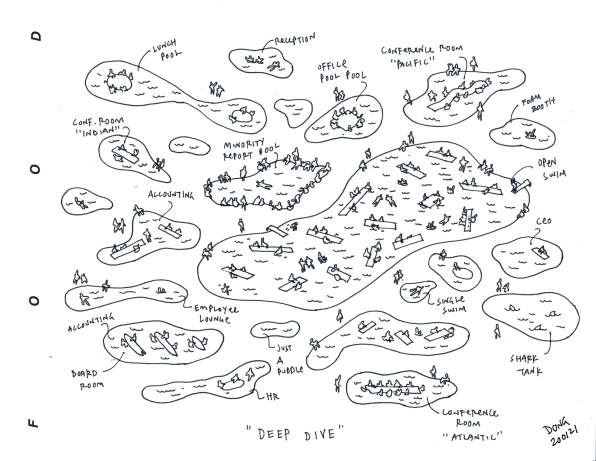
Food New York
The workplace of the future should be like every place in the future: connected with nature, integrated with the environment, and a place of productivity and joy.
With the tools that we work with becoming more mobile, and technology allowing us to work in all sorts of different places, the key for the future workplace won’t be how you work but where you work. The concept of an office space—a space dedicated to just working—will become obsolete. We can work anywhere. Why not work in places that are otherwise used to combat the anxieties and stresses of work: bathhouses, nature, places of play and fun? “Work” shouldn’t be a dedicated facet of one’s day—a necessary evil to support the more enjoyable aspects of life. It should itself be enjoyable. I love my work, and loving the environment you’re in helps you love the things you’re doing.
In both the context of climate change and just simply living on and with the Earth better, our built environments shouldn’t be seen as separate from the environments that they are built within. Separating our daily lives from the world all around us in the form of hermetically sealed, air-conditioned spaces makes it far too easy to ignore everything that we’re doing to the outdoors. The more we can connect to natural resources, the better we’ll be at taking care of those natural resources.
Also pools (and oceans and rivers and lakes) are always on the brain over here. —Dong-Ping Wong, founding director
(31)

